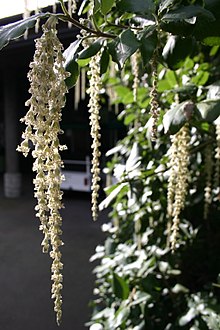Garrya
| Garrya | |
|---|---|
 |
|
| Garrya catkins in February at Woodland Park Zoo in Seattle, WA. | |
| Scientific classification | |
| Kingdom: | Plantae |
| (unranked): | Angiosperms |
| (unranked): | Eudicots |
| (unranked): | Asterids |
| Order: | Garryales |
| Family: | Garryaceae |
| Genus: |
Garrya Douglas ex Lindl. |
| Synonyms | |
|
Fadyenia Endl. |
|
Fadyenia Endl.
Garrya is a genus of flowering plants in the family Garryaceae, native to Mexico, the western United States, Central America and the Greater Antilles. Common names include silk tassel, and tassel bush
They are evergreen dioecious wind-pollinated shrubs growing to 1–5 m (3–16 ft) tall. The leaves are arranged in opposite pairs, and are simple, leathery, dark green to gray-green, ovate, 3–15 cm (1–6 in) long, with an entire margin and a short petiole. The flowers are gray-green catkins, short and spreading when first produced in late summer; the male catkins becoming long and pendulous in late winter when shedding pollen, 3–20 cm (1–8 in) long; the female catkins usually a little shorter and less pendulous. The fruit is a round dry berry containing two seeds.
Some species, notably Garrya elliptica, are widely cultivated in gardens for their foliage and the catkins produced in late winter. They are frequently grown against a wall, or as a windbreak in coastal areas. Male plants are more widely grown, as their catkins are longer and more attractive; one such cultivar, G. elliptica 'James Roof', has catkins up to 35 cm long. The hybrids G × issaquahensis (G. elliptica × G. fremontii) and G × thuretii (G. elliptica × G. fadyenii) have been bred for garden planting.
...
Wikipedia
